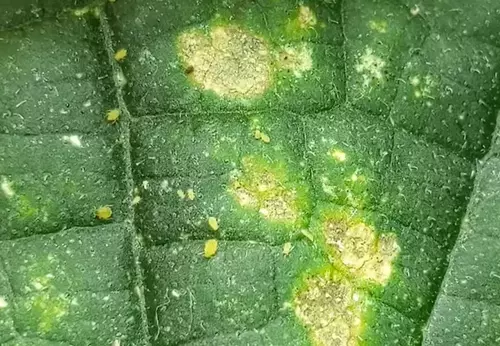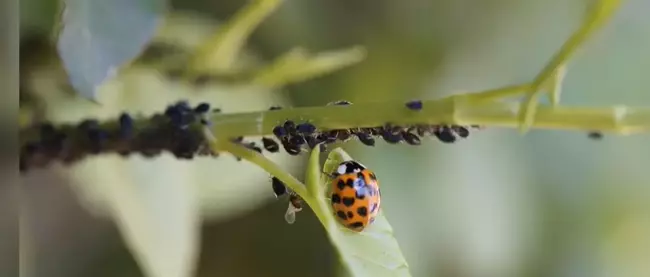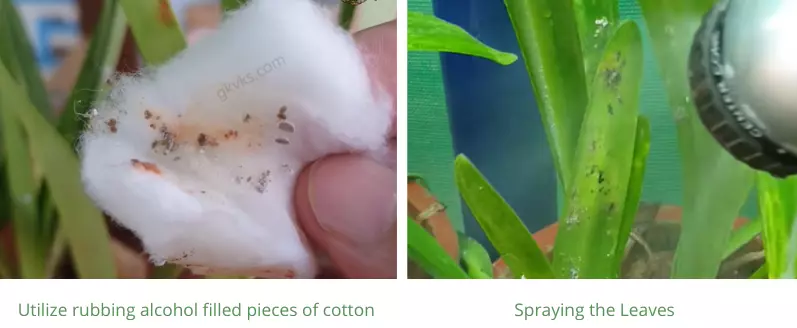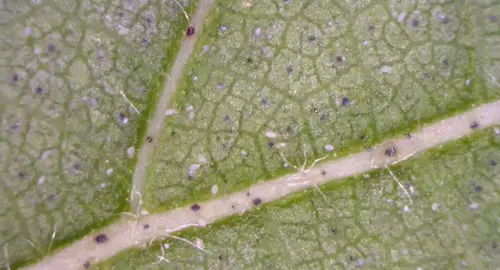Household pests are the most irritating and unwilling aspects one never wants to deal with. They create a very unsatisfying atmosphere in your garden. Furthermore, they also totally ruin the fascination of your fully maintained gardens.

These pests will affect the plantation to a great extent. Plants under an infestation attack give rise to rotten branches, discolored foliage, and poor appearance. So to survive this combat zone with little or no enduring harm, let us figure out how to perceive these common houseplant pests and manage them appropriately.
Common Houseplant Pests
It is crucial to control pests as soon as possible. Thus, to provide a comprehensive analysis of these pests, here we are depicting some of the most common houseplant pests and the straightforward method to get rid of them. Let’s find out it in detail;

1. Aphid
Aphid is a commonly found houseplant pest. It has the most apparent harm on delicate and new leaf tips.
Aphids have delicate and oval-shaped bodies that suck plant fluids and leave them wilted. Aphids reproduce asexually during spring and summer. They can develop new offspring in three weeks.

The aphids leave a sticky material on the leaves’ surface. This sticky substance attracts other small creatures, most possibly ants. The subterranean insects can harm your houseplants by building homes in the containers and attacking the roots.

Plant Affected:
Marantas, Alocasia Dragon scale, Pumpkin, melon, Squash, Bok choy, lettuce, bean, potatoes, and many more.
Treatment:
To get rid of aphids, utilize a hose or sink sprayer to dispose of the pests from the leaf axils or underside of the foliage. In addition, you can also utilize insecticidal cleanser or neem oil to hold aphids’ population attack in control.
Please spray the leaves with this spray mixture regularly until you get rid of the nuisance.

2. Scale
Scale is stationary or immobile shell-like projections that most precisely connect to the plants’ leaves and stems. It drains the juices out of your houseplant’s vascular framework, which can create a soft texture in your houseplant. They likewise spread rapidly and reproduce asexually. Therefore, take necessary treatment and prevention action rapidly as well as significantly.
Affected Plants:
Philodendron Moonlight, Silver Dragon Alocasia, Conifers, fruit trees, broadleaf shrubs, shade trees, etc., are all greatly influenced by the scaling attack.
Treatment:
We recommend using a manual removal method to get rid of scales. This method seems tiring, but it would prove very helpful for improving the garden and plants.
Please make a solution of 10% rubbing alcohol with water. Dip a cotton swab inside the solution, and clean the leaves to remove the scales from it.
This solution will act as an insecticidal treatment and help to relieve your plant from pest attacks. Please repeat the process after a regular interval until the issue is resolved.
Note: In case of using any solution on your plant, first have an attempt at a single leaf and wait for a reaction. If you do not observe any abnormality, you are free to apply the solution to the whole plant.

3. Mealybugs
Mealybugs are another nasty common houseplant pest. They are masters of stowing away from the human eye. It would help if you kept checking your houseplant for small cotton spots at the crossing points of leaves and stems as well as on leaf undersides.
The most prominent signs of mealybugs’ attack on your houseplant are excessive falling leaves and yellowish spots on them. New leaves are prone to Meally bugs attack.
Possible Prey:
Most of the time, mealybugs attack the fruit plants, Marantas, Philodendron Verrucosum, Alocasias, Pothos, African violets, tropical perennials, and other related options.
Treatment:
Certainly, getting rid of mealybugs is a complex way. Indeed, it appears so icky; however, utilize rubbing alcohol/water solution-filled pieces of cotton to eliminate mealybugs from the leaves and stems.

Please keep on spraying your plant leaves with the solution if you notice any activity of mealybugs around your plants.

4.Thrips
Thrips are one of the most popular houseplant bugs that leave your houseplant shriveled with spotted or striped leaves. Affected house plants might get pale and no longer survive due to the thrip assaults. They seem to be fragments or little shards in terms of appearance.
Plants Affected:
Cucurbits, Calatheas and solanaceous, along with various vegetable plants like cabbage, peas, and lettuce, are the most affected by thrips attack.
Treatment:
Please remove Thrips by showering your houseplant entirely with water, insecticidal cleanser, or neem oil. Repeat the process of cleaning once or twice within a week.

5. Spider mites
Spider mites are 8-legged pests, more similar to bugs, making networks on the undersides of leaves. Your houseplant might look pinpricked or dotted or transform into a weak bronze tone. Like other typical houseplant pests, spider mites can also cause severe harm to the plant and spread quickly to transmit.
Plants Affected:
Calatheas, Marantas, Ctenanthe, Philodendron Verrucosum, Blueberry, Strawberry, Tomato, Lettuce plants along with Marigolds, Viola, Lantana, and many other plants are affected by spider mite attack.
Treatment:
You can escape from spider mites by removing the contaminated stem and discarding it in a plastic sack. Wipe the leaves of your houseplant with a cloth soaked in neem oil or insecticidal cleanser. Repeat the cleaning process consistently for a little while.

Moreover, maintaining air circulation might be beneficial to Keep bug parasites away. Moreover, maintaining the proper humidity atmosphere helps in mitigating spider mites as they love dry weather

6. Fungus gnats
Fungus gnats flourish in the high humid atmosphere and damp soil conditions. You might find these pests on ferns and other damped surface water plants. The adult fungus gnats do not harm houseplants; however, their presence feels uncomfortable. In contrast, the fungus gnats larvae harm your houseplant by eating its delicate new roots. When present in large numbers, these larvae can weaken your houseplant after some time, and it will have stunted growth. Like aphids, the fungus gnats’ population also develops very rapidly.
Plants Affected:
Marantas, Caltheas ,Cyclamens, African violets, Poinsettias, Geraniums, and Carnations are more likely to be affected.
Treatment:
If you find fungus gnats on your plants, the primary thing you ought to do is to allow the dirt to dry out completely.
Moreover, hydrogen peroxide can be the best option for getting rid of this pest! Blend one part of 3% hydrogen peroxide with four parts of water. Prepare this mixture, and spray out your plant.
Hydrogen peroxide will flush out microscopic organisms and all other contagious development. Repeat the process until all the eggs of fungus gnats have been removed from the leaves’ surfaces.
You may use the yellow sticky traps to get rid of fungus gnats.

7. Whiteflies
Whiteflies are houseplant pests found in the atmosphere around the houseplants. They most commonly swarm around your houseplant. Moreover, they are sap-sucking bugs often tracked down on the undersides of leaves, and the affected plant looks limp and pale.
Plants affected:
These pests are a great danger to ornamental plants. apart from this, okra, eggplant, pepper, and all other warm vegetable plants.
Treatment:
You can eliminate whiteflies by splashing your houseplant entirely with water, insecticidal cleanser, or neem oil. Repeat this process every half of the month.

8. Broad Mites
Broad mites are types of little bugs or pests that harm numerous plants around your gardens. They are generally dynamic and more responsive toward the plants during the period of late spring. But this is an exception. You might find them active all year in your garden without any certainty. In addition, if it is not treated at the right time, it will cause the leaves to be distorted and crinkled.

Affected Plants:
The most common attack destination for broad flies is versatile ornamental plants. It might also harm fruit trees like melons and related species.
Treatment:
The broad mites cannot survive in hot conditions as they do not bear temperatures higher than 110° F. Some gardeners get rid of broad mites by dipping the small plants in hot water (between 110 -120°F) for 10 to 20 minutes.
If not the possibility, or you are scared to experiment with the hot tub treatment on your houseplant, place the plant in a hot place or enhance the temperature of the growth area for some time to kill off the broad mites.
Additional Tips
The most common way to keep the common houseplant pest from reaching the garden is to maintain suitable atmospheric conditions in your garden. Try to maintain a required humidity level, along with the proper exposure of plants to the sunlight and appropriate temperature for plants.
Moreover, never wait for the pest attack to happen. Once you have noticed even a tiny existence of these pests around your houseplants, begin the precautionary measure to radiate its presence.
Keep checking and inspecting your plants regularly to observe any unusual activity.
FAQs
What are the worst houseplant pests?
Aphids, Spider mites, and Mealybugs are common houseplant pests that adversely affect the health of houseplants. These pests are difficult to eliminate and take considerable effort to mitigate.
What are the little bugs around my house plants?
The small black insects flying around your houseplants or sitting in the soil are fungus gnats. They do not affect the plant badly except for their larvae in the soil. However, their presence seems to be annoying.
Does homemade insecticidal soap work?
Yes, the insecticidal soap solution is very helpful in eliminating houseplant pests. Furthermore, it is an environment-friendly remedy. The Castile liquid soap is the preferred option as it is natural and effective.
What is the best natural insecticide?
Chile pepper Insecticide Spray, neem Oil Insecticide, and garlic Insecticide Spray are some of the natural options you can attempt to get rid of houseplant pests.
How do you get rid of bugs in potting soil?
We recommend adding one part of 3% hydrogen peroxide to three parts of water. Deeply water your plant with the solution. The solution will kill the pests in the soil. However, the pests will try to escape from the soil top. Therefore, sprinkle diatomaceous earth on top of the soil, which can kill the remaining pests. Finally, place the plant in a ventilated area and do not water it until the soil becomes dry.
Final Note
Keeping all the perspectives on the forefront, hope you have the best idea about; Common houseplant pests and how to get rid of them. This is not a detailed study or report on pest management. However, if you are a beginner gardener, it would be sufficient to take early preventive steps against these unusual parasitic approaches.
Please give it a precise read to further clear your mind queries!
